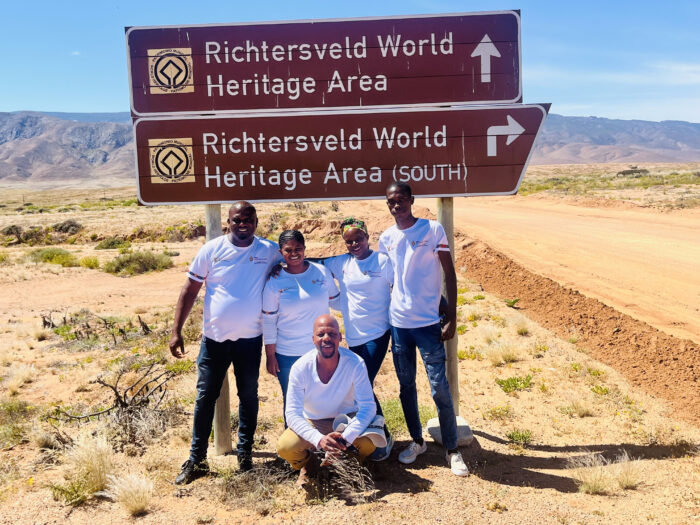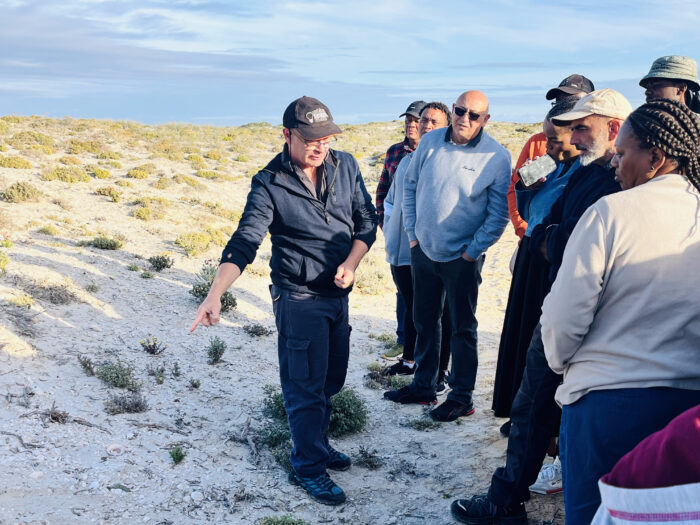The Heritage Management and Conservation Course Offered Hands-On Learning at Richtersveld Cultural Landscape
As part of the second implementation of the Heritage Management and Conservation Course, the National Heritage Council of South Africa (NHC), in collaboration with the University of Pretoria (UP), recently conducted a field visit to the Richtersveld Cultural and Botanical Landscape (Richtersveld) in the Northern Cape.
Recognised by the United Nations Educational, Scientific and Cultural Organisation (UNESCO) as a World Heritage Site, the Richtersveld has diverse stakeholders that are integral to the management of the site. These are the Northern Cape Department of Sport, Arts and Culture; South African National Parks (SANParks), the Department of Forestry, Fisheries and the Environment (DFFE) and the Nama Community under the Richtersveld Communal Property Association. It serves as a living classroom for heritage students and specialists, offering valuable insight into conservation and cultural challenges.
The visit was led by Dr Mirriam Tawane from the NHC and included research assistants from the organisation. The UP delegation consisted of internationally renowned Archaeologists Prof. Nick Shepherd from Aarhus University, Denmark, and Dr Sven Ouzman from the University of Western Australia. Heritage students participating in the programme are from Ditsong Museums of South Africa, Taung Skull World Heritage Site and Richtersveld Botanical and Cultural Landscape. This diverse group of heritage practitioners explored several significant heritage sites under the guidance of Mr Avron Thomas from the Northern Cape Namakwa District’s Department of Sports, Arts, and Culture (DSAC).
The first site visited was one of the five historical fountains in Port Nolloth, which, at one point, was a source of water, which, according to Mr Thomas, was one of the reasons why the Indigenous people remained in the area. “Despite the fountain’s cultural and historical importance, it remains neglected, with building developments encroaching on the historical site,” he expressed.
At the second site, known as the Midden, Mr Thomas explained that it was historically a fishing area for Indigenous communities, marked by seashell remains scattered on the ground. However, Prof. Shepherd and Dr Ouzman highlighted conservation challenges: “There has been insufficient research on the middens, and ongoing deterioration threatens this important heritage due to nearby building developments.” Prof. Shepherd further emphasised the educational potential of the site, noting, “Middens could serve as a valuable educational resource, especially for children to learn about cultural history through outreach programmes and direct interactions with the site.”
The visit also included a tour of the mine dumps and the Wondergat sinkhole, where fossilised plants were discovered. Dr Tawane highlighted the vulnerability of these rare fossil plants and stated, “These heritage resources require urgent protection from extreme weather, theft, and interests from private collectors.” Mr Thomas revealed plans to develop a museum in Koebus, suggesting, “The museum could also house a donation of fossil plants to the World Heritage Site, enhancing community and visitor engagement.”
At Koebus, the group was welcomed by Mr Nikodemus Swartbooi, chairperson of the Richtersveld Communal Property Association (CPA). He shared that the CPA has been foundational for the Nama Indigenous community’s development. Yet, he admitted, “Koebus and the CPA are still not where we aspire to be; there is much room for growth.”
A pressing issue identified during discussions with Mr Thomas, Mr Swartbooi, and Mr Marrio Maggott, a member of CPA, was the erosion of the Nama language due to apartheid-era policies. “Under Apartheid, the Nama people were forced to use Afrikaans exclusively, causing limitations on the recent generations to speak their mother tongue. Efforts to revive the language faced setbacks. There were previous attempts by the province to revive the education of the language. This was done in collaboration with the Namibian Government, but the programme faced several challenges that led to its failure. Even the extensive effort of a local teacher to teach the subject in a local school was affected by financial limitations, Mr Maggott explained.
“There is a significant literature gap regarding Nama language teaching materials in South Africa, especially when compared to Namibia, which exacerbates the risk of language extinction in the Koebus community.” He added.
The visit emphasised the complexity of conserving the Richtersveld Cultural Landscape, balancing heritage protection with community development and educational needs. It highlighted the necessity of coordinated efforts among heritage organisations, local communities, and international experts to safeguard the unique cultural and natural heritage of the RCL for future generations.


